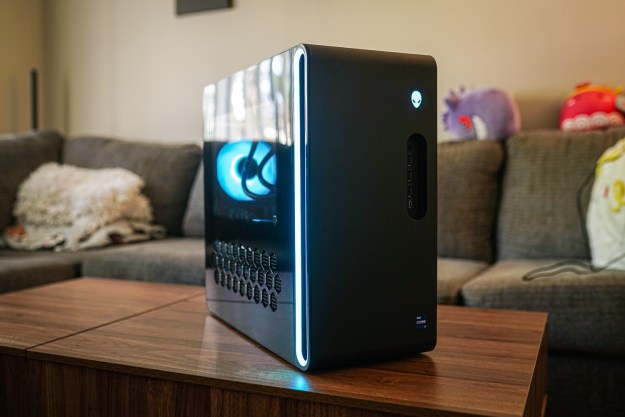
- Much smaller than previous versions
- Cool and quiet during operation
- Several configuration options
- Competitively priced
- Alienware Command Center is a bit annoying
- CPU lacks integrated graphics and overclocking support
Alienware is no stranger among the best gaming desktops, but its Aurora range has always been for a certain crowd: those who want that Alienware look. The updated Aurora R16 ditches that look with a completely redesigned chassis, all while maintaining the same level of components you could find in previous versions. Now, it’s a desktop that appeals to the masses.
Not only is the Aurora R16 half the size of last-gen’s Aurora R15, but it also comes in at a lower price for similar configurations. This desktop marks a new era for Alienware in many ways — and after using the Aurora R16, I’m along for the ride.
Alienware Aurora R16 specs
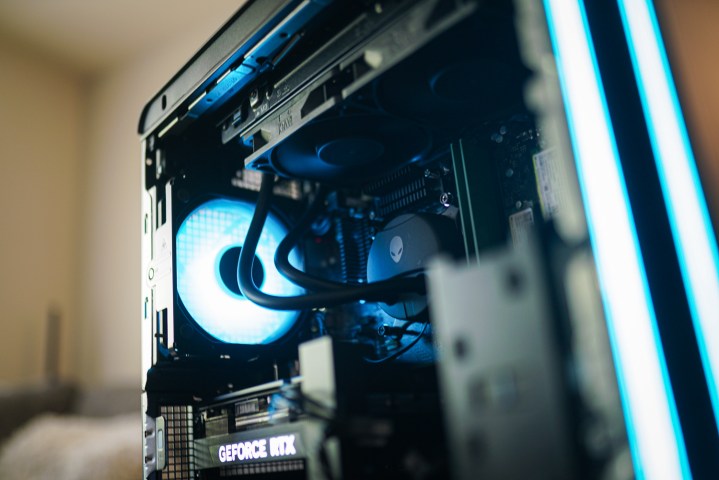
The Aurora R16 not only marks a major design change for Alienware but also a price reduction. The midrange model I reviewed clocks in at $2,000, though you can get it down to $1,500 if you knock down the RAM and storage.
The base configuration comes in at $1,300. For that, you get an Intel Core i7-13700F, an RTX 4060, 16GB of DDR5, and a 1TB NVMe SSD. You can scale much higher, though. For $4,980, you can get an Intel Core i9-13900F, Nvidia RTX 4090, 64GB of DDR5-5200, and 8TB of storage.
| CPU | Intel Core i7-13700F |
| GPU | Nvidia RTX 4070 |
| Motherboard | Custom Alienware Aurora LGA1700 motherboard |
| Case | Custom Aurora R16 mid-tower |
| Memory | 32GB (2 x 16GB) DDR5 |
| Storage | 2TB (1TB + 1TB) NVMe SSD |
| Power supply | 1,000W Platinum-rated power supply |
| USB ports | Front: 3x USB 3.2 Gen 1, 1x USB 3.2 Gen 2 Type-C / Rear: 2x USB 3.2 Gen 2 Type-C, 4x USB 2.0, 2x USB 3.2 Gen 1 |
| Networking | Gigabit Ethernet, Wi-Fi 6E, Bluetooth 5.2 |
| Price (as configured) | $1,999 |
The wide breadth of customization options is a major plus here. You had similar options with the Aurora R15, but they were more expensive. For instance, upgrading to the RTX 4090 inside the Aurora R16 is around $200 cheaper than it was in the R15, while an RTX 4080 is $150 less. That’s on top of a discount of around $300 to $500 depending on your configuration.
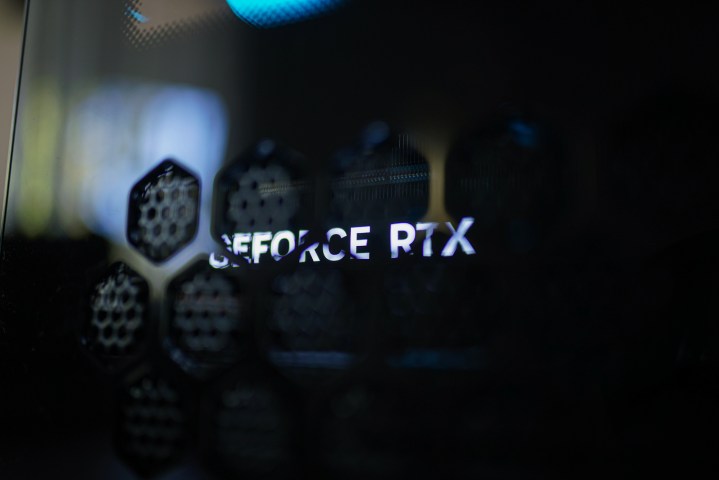
Great as a discount is, Alienware’s pricing is a little tricky. Some configurations require a 1,000W power supply. The Aurora R16 only comes with a 500W power supply in its base configuration. In addition, Alienware’s pricing is set assuming you want an air-cooled CPU and a solid side panel. Liquid cooling for the CPU and a clear side panel will cost you extra.
What’s frustrating about this setup is that every GPU option except the RTX 4060 and RTX 4060 Ti calls for more than a 500W power supply. Dell makes you jump straight to 1,000W. Frankly, the baseline power supply should be around 650W to 750W for a machine of this caliber, and without that, you’re forced to spend more on a PSU you don’t really need.
The ideal configuration comes in at $1,750. For that, you get the 1,000W PSU, a 240mm all-in-one liquid cooler, and a clear side panel, paired with an Intel Core i7-13700F, RTX 4070, 32GB of DDR5-5600, and 1TB of NVMe storage. At that price, the Aurora R16 is squarely competing with the Lenovo Legion Tower 5i, while coming in for significantly less than the Lenovo Legion Tower 7i.
The glow-up and grow-down
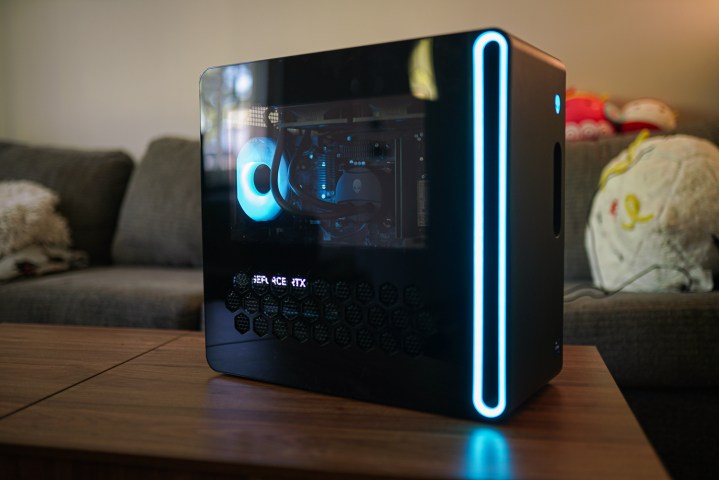
The Alienware Aurora R16 looks so much better. It’s now the size of a Dell XPS Desktop 8960, much unlike the massive plastic shell that covered previous versions. The end result is a petite PC that’s about 18 inches deep, 16.5 inches tall, and just shy of 8 inches wide, all while packing the most powerful components money can buy.
With a slimmer form, the Aurora R16 looks much nicer. It also comes with some updated flourishes. My favorite, by far, is the open intake at the front of the machine that’s adorned with Alienware’s Stadium Lighting. It looks great, and it serves a practical purpose for airflow. I do hope, however, that Alienware will add some removable dust filters to this design in the future.
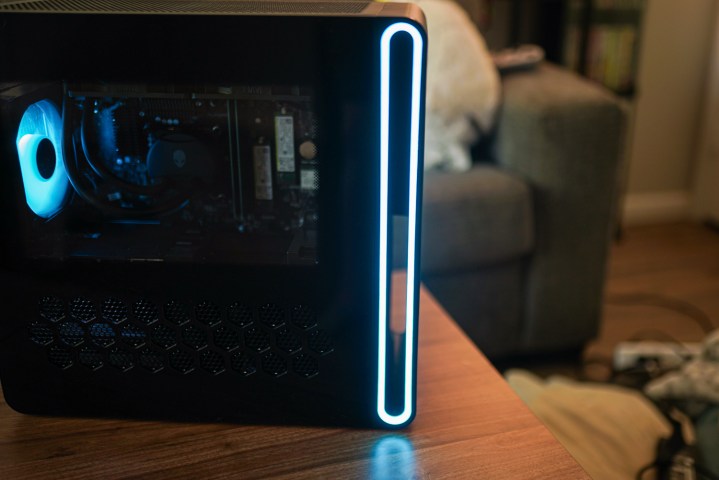
The side panel looks great, as well, assuming you opt for a clear side panel. Alienware uses acrylic instead of tempered glass, and it restricts the window to only the top portion of the inner chamber. That means you don’t see the cable mess below, but it also means you can’t fully appreciate the build inside. Thankfully, the bottom portion includes a honeycomb pattern for airflow, which looks great when stuck up against the window.
Inside the Aurora R16
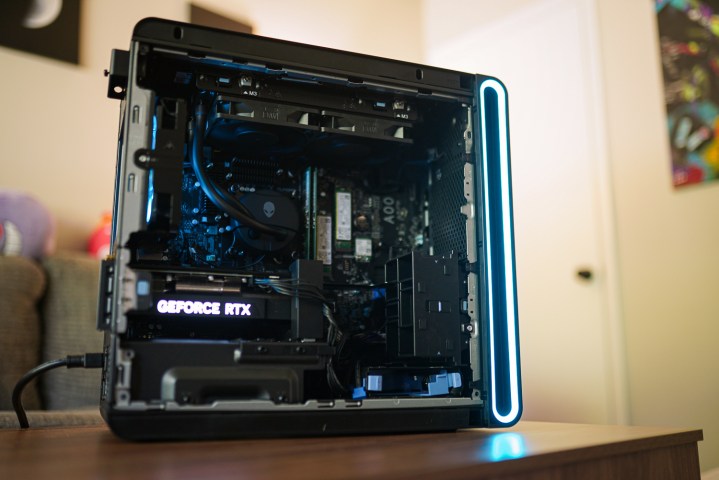
Getting inside the Aurora R16 is even easier than it was in the previous generation. Undo a single screw on the back, pull a tab, and the side panel will pop off. For the other side panel, you can just pop it out with enough force, though you shouldn’t need to get to the backside of the machine.
Everything is focused in the main chamber, as is usually the case for prebuilt desktops. Alienware still has its own motherboard design and a thin, server-like power supply, so those are off the table for upgrades. There’s great access to other upgrades you can make, though. Dual M.2 slots are available, one or both of which will be occupied depending on your configuration. You also have clear access to the two DDR5 RAM slots, as well as the LGA1700 CPU socket if you want to upgrade to the rumored Raptor Lake refresh.
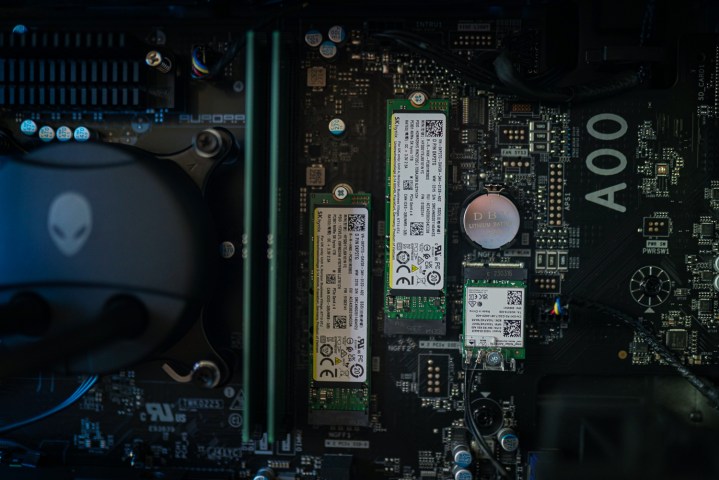
The big thing here is the preconfigured hard drive sled. All you need to do to upgrade your storage is take off the side panel, connect a 2.5-inch SSD or 3.5-inch HDD to the sled, and plug in the two routed cables. I wish more prebuilt desktops had pre-routed cables for storage expansion because it’s an upgrade that almost anyone can do for very little money.
That’s a big upside, but I still wonder what the Aurora R16 would look like with off-the-shelf components. There’s an argument here that you need the special motherboard and power supply for how small the machine is, but the end result is a mess of brackets and supports that makes the internals look less good than they could.
A CPU problem
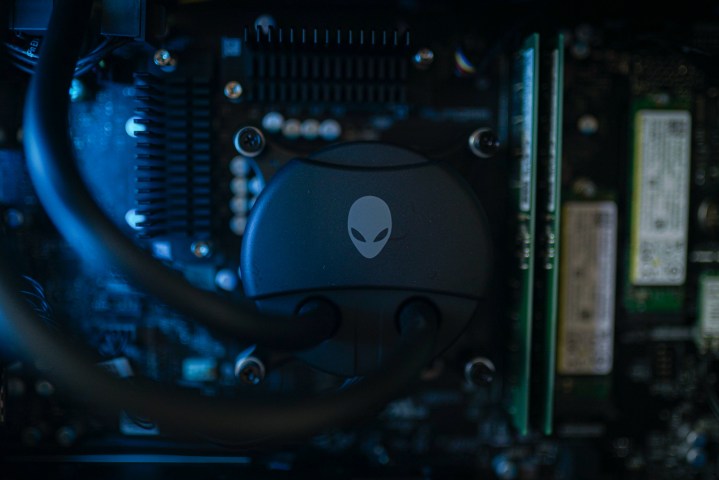
Although Alienware claims that the Aurora R16 will be its most powerful desktop ever, now available with up to an RTX 4090, the CPU is cut back. That’s because Alienware opted to use non-K models, unlike previous versions. These models aren’t unlocked for overclocking, and based on my testing, the Core i7-13700F inside the Aurora R16 is a little slower than the K model inside the Dell XPS Desktop 8960.
| Alienware Aurora R16 (Core i7-13700F) | Lenovo Legion Tower 7i (Core i9-13900KF) | Dell XPS Desktop (core i7-13700K) | |
| Cinebench R23 (single/multi) | 1,897 / 18,987 | 2,171 / 36,783 | 2,087 /24,061 |
| Geekbench 5 (single/multi) | 1,838 / 16,703 | 2,095 / 21,742 | 1,974 /17,486 |
| Geekbench 6 (single/multi) | 2,671 / 15,348 | 2,785 / 17,786 | N/A |
| Pugetbench for Premiere Pro | 828 | 1,072 | 1,189 |
The F suffix has implications, too, particularly in apps like Premiere Pro where you can leverage integrated graphics along with your GPU to speed up certain tasks. Both the Lenovo and Dell competitors here come with an RTX 4080, explaining their much higher scores in Premiere Pro, but the extra boost from integrated graphics would help to speed up these workloads.
From my testing, it seems the chip is tuned slightly lower to keep thermals and noise at bay. That works, but it also means you have a less powerful processor as a result. That’s not a huge deal for gaming, but for users who want to have productivity and gaming performance, a larger machine like the Lenovo Legion Tower 7i will be a better option.
Great for 1440p, acceptable for 4K
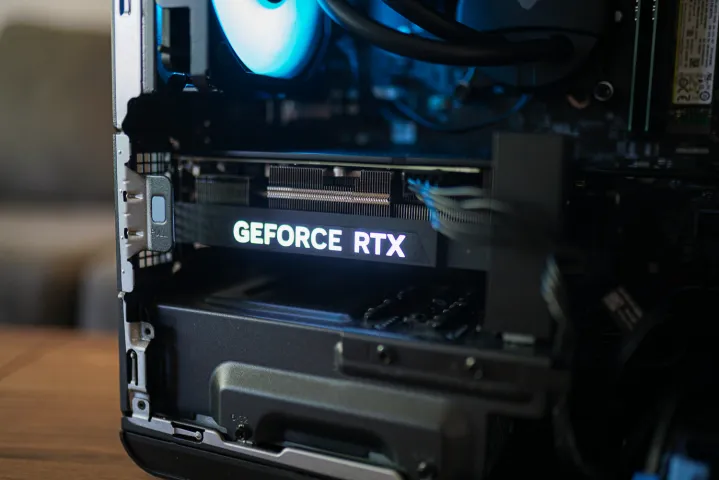
You’re going to buy the Aurora R16 for gaming primarily, and it’s blisteringly fast. Building your own PC can still net higher performance, especially with some part changes, but my testing shows that the Aurora R16 is leveraging most of the power of the RTX 4070 inside.
Starting with 3DMark, the Aurora R16 is within spitting distance of a custom RTX 4070 desktop with AMD’s Ryzen 9 7950X. The Lenovo Legion Tower 7i is far ahead in Time Spy, but it’s also packing an RTX 4080. Read our RTX 4080 review to see just how much faster that GPU really is.
| Alienware Aurora R16 (RTX 4070) | Lenovo Legion Tower 7i (RTX 4080) | Custom RTX 4070 desktop (Ryzen 9 7950X) | |
| 3DMark Time Spy | 16,736 | 24,554 | 17,237 |
| 3DMark Fire Strike | 34,546 | N/A | N/A |
| 3DMark Port Royal | 10,652 | N/A | 11,046 |
Onto real games, the Aurora R16 can handle most games at 4K Ultra while cracking 60 frames per second (fps). The major exception is Cyberpunk 2077, which definitely needs the help of Nvidia’s DLSS 3 to reach higher levels of performance at this resolution. Thankfully, DLSS 3 is available to the Aurora R16 with its RTX 40-series graphics card.
You can really see just how much faster an RTX 4080 is here. The Legion Tower 7i has a nicer processor, as well, but at 4K, you’re almost always limited by the graphics card. The Aurora R16 is also slightly behind the custom RTX 4070 desktop, but never by more than a handful of frames. Overall, you might be looking at a performance loss in the low single digits, but nothing that should be concerning.
| Alienware Aurora R16 (RTX 4070) | Lenovo Legion Tower 7i (RTX 4080) | Custom RTX 4070 desktop (Ryzen 9 7950X) | |
| Cyberpunk 2077 | 32 fps | 62 fps | 42 fps |
| Cyberpunk 2077 (Ultra RT w/ DLSS 3) | 71 fps | 115 fps | 73 fps |
| Forza Horizon 5 | 98 fps | 136 fps | 106 fps |
| Assassin’s Creed Valhalla | 66 fps | 100 fps | 65 fps |
| Red Dead Redemption 2 | 62 fps | 97 fps | 67 fps |
| Horizon Zero Dawn | 74 fps | N/A | 78 fps |
The RTX 4070 isn’t built for 4K. That’s the purpose of the RTX 4080, so 1440p is more realistic for people in the market for the Aurora R16. Here, the machine can easily clear 60 fps in games like Cyberpunk 2077 and generally top 100 fps in most other titles.
While that’s a good mark for the Aurora R16 to pass, you can see the gap between it and the custom RTX 4070 grow at this resolution. That’s likely an influence of the CPU — the Ryzen 9 7950X is significantly more powerful than the Core i7-13700F — but it’s not a full explanation. The Aurora R16, even ignoring the CPU difference, is still lagging a bit behind what you can get with a custom desktop.
| Alienware Aurora R16 (RTX 4070) | Custom RTX 4070 desktop (Ryzen 9 7950X) | |
| Cyberpunk 2077 | 73 fps | 82 fps |
| Cyberpunk 2077 (Ultra RT w/ DLSS 3) | 115 fps | 121 fps |
| Forza Horizon 5 | 138 fps | 148 fps |
| Assassin’s Creed Valhalla | 111 fps | 99 fps |
| Red Dead Redemption 2 | 98 fps | 112 fps |
| Horizon Zero Dawn | 135 fps | 146 fps |
Although the Aurora R16 isn’t quite as powerful as a custom PC, it’s still very fast. The components for a similarly configured desktop would run you around $1,700, making the Alienware’s building fee essentially free.
Be gone, sidebar
Alienware’s desktops come with a variety of utilities, some of which are more useful than others. I appreciate the update center for grabbing new BIOS versions and graphics drivers, and the updated Alienware Command Center allows you to customize lighting and see stats like your GPU temperature and average frame rate in games.
My big issue is the Alienware Command Center overlay. It lives on the side of your monitor; a tiny cyan sliver that never disappears. You can open it up through a hotkey to see system stats, as well as click on it. That’s the problem. All too often, you’ll click on the sidebar while playing games, forcing you out of the game and into Alienware’s utility. Thankfully, you can disable this in the setting of Alienware Command Center (thanks to the reader who pointed that out), but this should definitely be an opt-in utility.
Multiple improvements
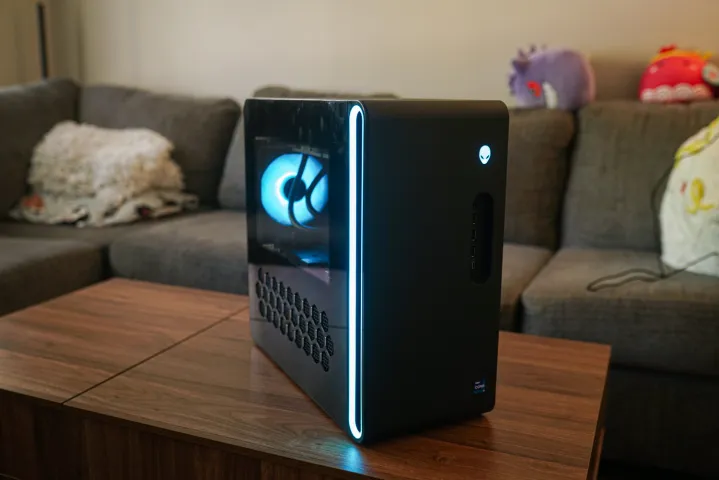
Despite a few issues — the locked CPU and Command Center sidebar chief among them — there’s no denying the Aurora R16 is a massive leap forward for Alienware. Not only is the design attractive and practical, but the Aurora R16 also comes in at a significantly cheaper price than previous versions, finally making it competitive with other gaming desktops.
As usual, building your own gaming PC is the best way to go for cost and overall performance, but the Aurora R16 sacrifices very little by being a prebuilt. Even the proprietary components, which have stuck out in previous versions due to the massive case design, make more sense here with the Aurora R16’s overall slim form factor.





